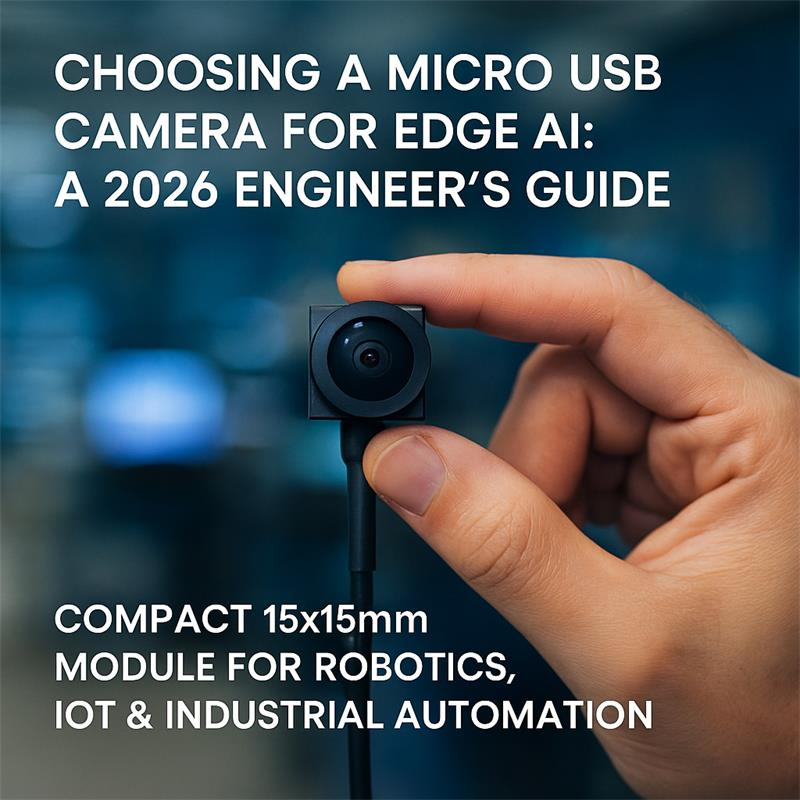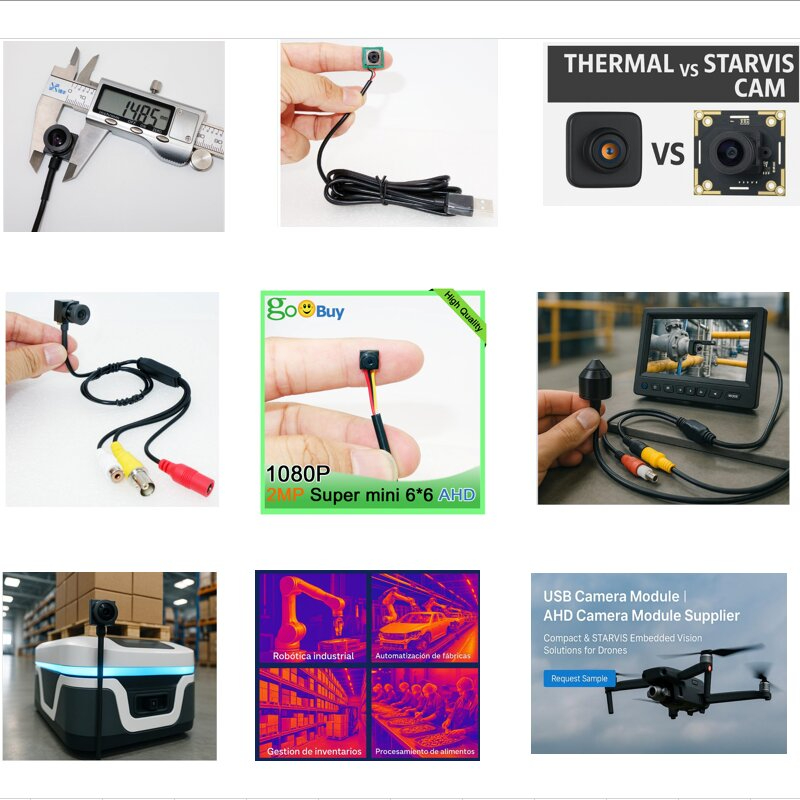
This engineering guide explores the selection of 15x15mm Micro USB Camera Modules for space-critical Edge AI applications. Unlike bulky standard cameras, these miniature Autofocus (AF) modules allow Smart Retail Kiosks, Portable Medical Devices, and Embedded Industrial Systems to achieve clear 4K/1080p imaging at variable distances without mechanical adjustments, ensuring high ROI and rapid integration for 2026 deployments
Introduction: Your Algorithm is Brilliant. Is Your Vision?
Your Edge AI model is trained, optimized, and ready to deploy. But in the real world, its performance depends entirely on the quality of the data it receives. For any embedded vision project, your camera isn’t just a component—it’s the source of truth. A poor choice here can become the bottleneck for your entire system.
The challenge many engineers face is selecting a camera that balances resolution, autofocus, form factor, and software integration for platforms like NVIDIA Jetson or Raspberry Pi. This blog provides a practical framework: critical decision factors, real-world scenarios, and a product recommendation tailored for Edge AI success.
The New Reality: Why Edge AI Demands a New Class of Camera
The "Why Now" Drivers
The Consequence
This shift has created urgent demand for a new class of vision sensor: compact yet powerful,
versatile yet easy to integrate. This is where high-performance embedded USB cameras excel.
The 4 Critical Decision Factors for Your Edge AI Camera
Factor 1: Resolution vs. AI Model Requirements – More Isn’t Always Better
A 12MP sensor captures immense detail, but also burdens the edge processor. A 2MP sensor, in contrast,
runs far faster.
Guideline:
In short: match your camera resolution to your AI inference pipeline.
Factor 2: The Autofocus Imperative – From Blurry Data to Sharp Insights
Fixed-focus cameras are a liability when working with dynamic distances. In robotics, a blurry frame means misidentifying parts; in healthcare, it means missed anomalies.
Our 15×15mm micro USB autofocus cameras eliminate this risk, adjusting seamlessly whether the target is 10cm
or 1 m away. For barcode scanning, robotic bin-picking, or medical devices, autofocus ensures your AI receives sharp, usable frames every time.
Factor 3: The Size-to-Performance Ratio – Why Miniaturization is Critical
As embedded systems shrink, space becomes the ultimate constraint. Drone gimbals, robotic end-effectors, and handheld inspection tools cannot accommodate bulky vision systems.
Here lies the advantage of our miniature USB cameras: the 15×15mm form factor packs full resolution,
autofocus, and UVC compliance into a package small enough to fit anywhere.
Factor 4: UVC Compliance – The Key to Rapid Prototyping and Deployment
Proprietary SDKs and drivers slow engineers down. A true UVC-compliant USB camera works out-of-the-box
with Windows, Linux, macOS, Jetson, and Android.
This reduces time-to-market and lowers development costs—a decisive advantage for startups and established
OEMs alike.
Engineering Note: Moving Robots vs. Static Kiosks While our 15x15mm Autofocus series is perfect for static applications like kiosks and document scanning (OCR), fast-moving robots (AMR/Drones) require Global Shutter sensors to avoid image distortion ("Jello Effect").
For Static AI (Scanning/Face ID): Choose our 8MP/12MP Autofocus modules.
For High-Speed AI (Navigation): Choose our OV9281 Global Shutter Series.

Application Scenarios: Matching Our Modules to Your Mission
Scenario 1: High-Detail Industrial Inspection (USA)
A Michigan electronics company was developing an Automated Optical Inspection (AOI) machine.
Their goal: detect microscopic soldering defects on PCBs.
Scenario 2: High-Speed Logistics & Retail (Europe)
A German logistics hub deploying self-checkout kiosks faced barcode scanning issues across varied
distances and angles.
Scenario 3: Smart IoT & Presence Detection (Smart Home Sector)
A French smart home OEM needed low-cost sensors for presence detection in home security systems.
Your Solution: shenzhen Novel Electronics limited Micro USB Camera Series
At Shenzhen Novel Electronics Limited, we developed the 15×15mm Goobuy UC-501 USB camera series as a unified,
scalable platform for Edge AI.
Pain Point: Backlight interference (store windows) and cost pressure.
The Trap: Buying expensive 4K cameras that overheat in enclosed kiosks.
The Goobuy Solution: IMX291 (1080p) or IMX307. Large pixels capture faces clearly in mixed lighting. 1080p is sufficient for gender/age detection algorithms, saving CPU load for ad rendering.
Pain Point: Need to connect 4+ cameras to one box; Bandwidth bottlenecks.
The Trap: Using 4K MJPEG cameras that saturate the USB bus, causing frame drops.
The Goobuy Solution: IMX335 (5MP). The 4:3 aspect ratio is perfect for conveyor belts. Stable, mature drivers ensure 24/7 uptime. Pro Tip: Use our H.264 version for multi-camera setups.
Need stable 5MP for Inspection? Get the [Goobuy UCM-IMX335 IMX335 usb camera Datasheet]
Pain Point: Motion blur causes VSLAM localization loss ("Robot gets lost").
The Trap: Using Rolling Shutter sensors for fast-moving bots.
The Goobuy Solution: Global Shutter Series (OV9281 / IMX296). Freezes motion instantly. Essential for reliable navigation.
Pain Point: Scanning QR codes and faces at different distances.
The Trap: Fixed focus cameras produce blurry QR codes close up.
The Goobuy Solution: IMX179 Autofocus. Cheap, effective, and allows the customer to wave the product naturally.
Pain Point: Old machines, dark corners, need low latency.
The Trap: IP cameras have too much lag for machine operation monitoring.
The Goobuy Solution: AHD or IMX327 USB. Pure low-light visibility to see into dark machinery.

Comparison Table
|
Model |
Resolution |
Best Use Case |
Key Advantage |
|
2MP USB |
1920×1080 |
IoT, presence detection |
Low power, low cost |
|
5MP USB |
2592×1944 |
Logistics, kiosks |
Balanced speed + detail |
|
8MP USB |
3264×2448 |
Robotics, drones |
Wider field + HDR |
|
12MP USB |
3840×2160 |
AOI, precision inspection |
Extreme detail + autofocus |
| Resolution | Sensor Model (Critical!) | Focus Type | Shutter Type | Best Edge AI Application |
| 2 MP | Sony IMX307 | Fixed / AF | Rolling | Presence Detection / IoT (Low Cost) |
| 5 MP | Sony IMX335 | Fixed / AF | Rolling | Kiosks / Digital Signage (Balanced) |
| 8 MP | Sony IMX179 | Autofocus | Rolling | OCR Scanning / Smart Retail |
| 1 MP | OmniVision OV9281 | Fixed Focus | Global | Fast Robotics / VSLAM (No Motion Blur) |
| AI Platform | Recommended Max Resolution (USB 3.0) | Best Sensor Match |
| Raspberry Pi 4/5 | 1080p @ 60fps / 5MP @ 30fps | IMX291 / IMX335 |
| NVIDIA Jetson Nano | 4K @ 30fps (Single) | IMX415 |
| NVIDIA Jetson Orin | 4K @ 60fps (Dual) | IMX678 / IMX585 |
| Intel NUC / x86 PC | Multi-Cam H.264 | IMX323 (H.264) |
This unified architecture means you can scale from entry-level IoT sensors to precision industrial
vision without redesigning your mechanical or base software stack.
Conclusion: Your Vision, Accelerated
Choosing the right camera is a strategic decision that directly influences your Edge AI’s success.
It’s about striking the perfect balance between resolution, size, autofocus, and integration ease.
Our micro USB camera modules are engineered for exactly this balance—compact, versatile,
and ready to integrate into your embedded AI systems.
Call to Action
Ready to future-proof your Edge AI device? Get our free camera module comparison chart,
or contact our engineers for a tailored consultation.
A: The module utilizes a miniature Voice Coil Motor (VCM) lens to achieve a focus range from 10cm to Infinity. This allows it to capture clear macro shots of documents (OCR) or barcodes in Smart Retail Kiosks, while also being able to focus on users' faces standing 1-2 meters away for identity verification.
A: Yes. The 15x15mm module is fully compliant with the USB Video Class (UVC) protocol. It is plug-and-play on Linux (Ubuntu/Debian), Android, Windows, and macOS. It works seamlessly with standard libraries like OpenCV, V4L2, and GStreamer on Edge AI platforms like NVIDIA Jetson and Raspberry Pi.
A: The Sony IMX179 (8MP) is chosen for its mature driver support and excellent price-to-performance ratio. It delivers 4K resolution (3264x2448) in a tiny 1/3.2" optical format, making it the only sensor capable of fitting into our ultra-compact 15x15mm housing while providing the high resolution needed for text scanning and digital zooming.
A: While the module is designed for low-power consumption, compact high-resolution sensors do generate heat. For 24/7 operation in enclosed Industrial AI Boxes or handheld probes, we recommend attaching a small thermal pad or heatsink to the back of the PCB to transfer heat to the device's main chassis, ensuring long-term stability.
A: Choose Autofocus (AF) if your target distance changes dynamically, such as a customer approaching a Self-Checkout Terminal or a handheld medical inspection tool. Choose Fixed Focus (FF) if your target is always at a known distance (e.g., a conveyor belt camera), as FF lenses are more vibration-resistant for moving robots.